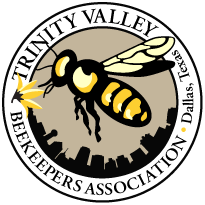Your Cart is Empty
A Dallas Based Beekeepers Association serving the North Texas Area
A Dallas Based Beekeepers Association serving the North Texas Area

Have Unwanted Bees?
Don't panic, they don't cause any damage.
-
While it cannot be guaranteed that bees in a swarm won’t sting, a swarm is generally very docile because they don’t have a hive with honey and baby bees to defend. Just before swarming, bees gorge themselves with honey. When gorged with honey they are content like grandpa after a Thanksgiving Day feast.
-
Trinity Valley Beekeepers recommends live removal and relocation for two reasons. Live removal & relocation is environmentally friendly. While extermination appears at first glance the quickest and easiest solution, extermination still requires removal of comb, honey and the bees. If left in the structure such as a wall, the dead bees will smell bad and the honey will either ferment or attract more bees, ants, wax moths and rodents. This can lead to more costly repairs in the future.
-
Occasionally with swarms, but very rarely with established colonies. While the honey bees do have some value, in most removal situations the labor and costs of removal are more than the value of the bees at their unwanted location. Often beekeepers who do charge are still more affordable than what many exterminators charge for killing a bee colony.
-
Refer to the Removal Guidelines (see below) page for our suggestions.
-
A good place to start is to contact the beekeepers’ association in your area.
If the hive is located in Dallas or the surrounding counties, a request to have a participating member of the Trinity Valley Beekeepers Association contact you by going to the Removal Request page and fill out the form and submit.
Beehive Removal Frequently Asked Questions
Please read our Removal Guidelines to help you make the right decisions for yourself and the bees.
Removal GuidelinesSubscribe
Sign up to get the latest on all things buzzing.
